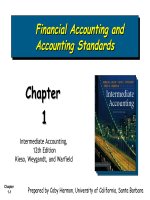Intermediate accounting 13th kieso warfield chapter 01
Bạn đang xem bản rút gọn của tài liệu. Xem và tải ngay bản đầy đủ của tài liệu tại đây (817.56 KB, 35 trang )
Chapter
1-1
CHAPTER
1
FINANCIAL ACCOUNTING AND
ACCOUNTING STANDARDS
Intermediate Accounting
13th Edition
Kieso, Weygandt, and Warfield
Chapter
1-2
Learning
Learning Objectives
Objectives
1.
Identify the major financial statements and other means of
financial reporting.
2.
Explain how accounting assists in the efficient use of scarce
resources.
3.
Describe some of the challenges facing accounting.
4.
List the objectives of financial reporting.
5.
Explain the need for accounting standards.
6.
Identify the major policy-setting bodies and their role in the
standard-setting process.
7.
Explain the meaning of generally accepted accounting principles
(GAAP) and the role of the Codification for GAAP.
8.
Describe the impact of user groups on the rule-making process.
9.
Understand issues related to ethics and financial accounting.
Chapter
1-3
Financial
Financial Accounting
Accounting and
and Accounting
Accounting Standards
Standards
Financial
Statements and
Financial Reporting
Accounting and
capital allocation
Challenges
Objectives
Need to develop
standards
Chapter
1-4
Parties Involved in
Standard Setting
Securities and
Exchange
Commission
American Institute of
CPAs
Financial
Accounting
Standards Board
Changing role of the
AICPA
Generally Accepted
Accounting
Principles
FASB Codification
Issues in Financial
Reporting
Political environment
Expectations gap
International
accounting standards
Ethics
Financial
Financial Statements
Statements and
and Financial
Financial Reporting
Reporting
Essential characteristics of accounting are:
(1) the identification, measurement, and
communication of financial information about
(2) economic entities to
(3) interested parties.
Chapter
1-5
LO 1 Identify the major financial statements and other means of financial reporting ..
Financial
Financial Statements
Statements and
and Financial
Financial Reporting
Reporting
Economic Entity
Financial Statements
Additional Information
Financial
Information
Balance Sheet
President’s letter
Income Statement
Prospectuses,
Statement of Cash
Flows
SEC Reporting
Accounting?
Identifies
and
Measures
and
Communicates
Statement of
Owners’ or
Stockholders’ Equity
Note Disclosures
GAAP
Chapter
1-6
News releases
Forecasts
Environmental
Reports
Etc.
Not GAAP
LO 1 Identify the major financial statements and other means of financial reporting ..
Financial
Financial Statements
Statements and
and Financial
Financial Reporting
Reporting
Review
What is the purpose of information presented in
notes to the financial statements?
a. To provide disclosure required by generally
accepted accounting principles.
b. To correct improper presentation in the financial
statements.
c. To provide recognition of amounts not included in
the totals of the financial statements.
d. To present management’s responses to auditor
comments.
Chapter
1-7
LO 1 Identify the major financial statements and other means of financial reporting ..
Accounting
Accounting and
and Capital
Capital Allocation
Allocation
Resources are limited. Efficient use of resources often
determines whether a business thrives.
Illustration 1-1
Capital Allocation Process
Financial
Financial
Reporting
Reporting
Information to help
users with capital
allocation decisions.
Chapter
1-8
Users
Users
Investors, creditors,
and other users
Capital
CapitalAllocation
Allocation
The process of
determining how and
at what cost money
is allocated among
competing interests.
LO 2 Explain how accounting assists in the efficient use of scare resources.
Accounting
Accounting and
and Capital
Capital Allocation
Allocation
Review
An effective process of capital allocation is critical to a
healthy economy, which
a. promotes productivity.
b. encourages innovation.
c. provides an efficient and liquid market for buying
and selling securities.
d. All of the above.
Chapter
1-9
LO 2 Explain how accounting assists in the efficient use of scare resources.
Challenges
Challenges Facing
Facing Financial
Financial Accounting
Accounting
Nonfinancial Measurements
Forward-looking Information
Soft Assets
Timeliness
Chapter
1-10
LO 3 Describe some of the challenges facing accounting.
Objectives
Objectives of
of Financial
Financial Accounting
Accounting
Financial
Financial reporting
reportingshould
shouldprovide
provideinformation
informationthat:
that:
(a)
(a) isisuseful
usefulto
topresent
presentand
andpotential
potentialinvestors
investorsand
andcreditors
creditorsand
and
other
otherusers
usersin
inmaking
makingrational
rationalinvestment,
investment,credit,
credit,and
andsimilar
similar
decisions.
decisions.
(b)
(b) helps
helpspresent
presentand
andpotential
potentialinvestors
investorsand
andcreditors
creditorsand
andother
other
users
usersin
inassessing
assessingthe
theamounts,
amounts,timing,
timing,and
anduncertainty
uncertaintyof
of
prospective
prospectivecash
cashreceipts.
receipts.
(c)
(c) clearly
clearlyportrays
portraysthe
theeconomic
economicresources
resourcesof
ofan
anenterprise,
enterprise,the
the
claims
claimsto
tothose
thoseresources,
resources,and
andthe
theeffects
effectsof
oftransactions,
transactions,
events,
events,and
andcircumstances
circumstancesthat
thatchange
changeits
itsresources
resourcesand
and
claims
claimsto
tothose
thoseresources.
resources.
Chapter
1-11
LO 4 List the objectives of financial reporting.
Objectives
Objectives of
of Financial
Financial Accounting
Accounting
Review
All of the following are objectives of financial
reporting except to provide information
a. About enterprise resources, claims to those
resources, and changes in them.
b. That is useful in investment and credit decisions.
c. About the management and major shareholders of
an enterprise.
d. That is useful in assessing cash flow prospects.
Chapter
1-12
LO 4 List the objectives of financial reporting.
Need
Need to
to Develop
Develop Standards
Standards
Various users
need financial
information
The accounting profession
has attempted to develop a
set of standards that are
generally accepted and
universally practiced.
Chapter
1-13
Financial Statements
Balance Sheet
Income Statement
Statement of Stockholders’ Equity
Statement of Cash Flows
Note Disclosure
Generally Accepted
Accounting Principles
(GAAP)
LO 5 Explain the need for accounting standards.
Parties
Parties Involved
Involved in
in Standard
Standard Setting
Setting
Three organizations:
Securities and Exchange Commission (SEC)
American Institute of Certified Public
Accountants (AICPA)
Financial Accounting Standards Board (FASB)
Chapter
1-14
LO 6 Identify the major policy-setting bodies and
their role in the standard-setting process.
Securities
Securities and
and Exchange
Exchange Commission
Commission
Established by federal government
Accounting and reporting for public companies
Securities
Securities
Act
Act of
of 1933
1933
Securities
Securities
Act
Act of
of 1934
1934
Encouraged private standard-setting body
SEC requires public companies to adhere to GAAP
SEC Oversight
Enforcement Authority
Chapter
1-15
LO 6 Identify the major policy-setting bodies and
their role in the standard-setting process.
American
American Institute
Institute of
of CPAs
CPAs
National professional organization
Established the following:
Committee
Committee on
on
Accounting
Accounting
Procedures
Procedures
Chapter
1-16
Accounting
Accounting
Principles
Principles Board
Board
1939 to 1959
1959 to 1973
Issued 51 Accounting
Research Bulletins
(ARBs)
Issued 31 Accounting
Principle Board
Opinions (APBOs)
Problem-by-problem
approach failed
Wheat Committee
recommendations
adopted in 1973
/>
LO 6
Financial
Financial Accounting
Accounting Standards
Standards Board
Board
Wheat Committee’s recommendations resulted in the creation of a
the Financial Accounting Standards Board in 1973.
Financial
Financial
Accounting
Accounting
Foundation
Foundation
Financial
Financial
Accounting
Accounting
Standards
Standards Board
Board
Financial
Financial Accounting
Accounting
Standards
Standards Advisory
Advisory
Council
Council
Chapter
1-17
Selects members of the FASB
Funds their activities
Exercises general oversight.
Mission to establish and improve
standards of financial accounting
and reporting.
Consult on major policy issues.
LO 6 Identify the major policy-setting bodies and
their role in the standard-setting process.
Financial
Financial Accounting
Accounting Standards
Standards Board
Board
Missions is to establish and improve standards of
financial accounting and reporting. Differences between
FASB and APB include:
Smaller Membership
Full-time, Remunerated Membership
Greater Autonomy
Increased Independence
Broader Representation
Chapter
1-18
/>
LO 6 Identify the major policy-setting bodies and
their role in the standard-setting process.
Financial
Financial Accounting
Accounting Standards
Standards Board
Board
Review
The first step taken in the establishment of a typical
FASB statement is
a. The board conducts research and analysis and a
discussion memorandum is issued.
b. A public hearing on the proposed standard is held.
c. The board evaluates the research and public
response and issues an exposure draft.
d. Topics are identified and placed on the board’s
agenda.
Chapter
1-19
LO 6 Identify the major policy-setting bodies and
their role in the standard-setting process.
Due
Due Process
Process
FASB relies on two basic premises:
Responsive to entire economic community
(2) Operate in full view of the public
(1)
Step 1 = Topic placed on agenda
Step 2 = Research conducted and Discussion Memorandum
issued.
Step 3 = Public hearing
Step 4 = Board evaluates research, public response and
issues Exposure Draft
Step 5 = Board evaluates responses and issues final
Statement of Financial Accounting Standard
Chapter
1-20
LO 6 Identify the major policy-setting bodies and
their role in the standard-setting process.
Types
Types of
of Pronouncements
Pronouncements
Issued by the FASB:
Standards, Interpretations, and Staff Positions.
Financial Accounting Concepts
Emerging Issues Task Force Statements
Chapter
1-21
LO 6 Identify the major policy-setting bodies and
their role in the standard-setting process.
Types
Types of
of Pronouncements
Pronouncements
CA1-11 (Accounting Pronouncements) Standard setting bodies have issued a
number of authoritative pronouncements. A list is provided on the left, below,
with a description of these pronouncements on the right.
(d)
(f)
(c)
(e)
(a)
(b)
Chapter
1-22
LO 6 Identify the major policy-setting bodies and
their role in the standard-setting process.
Changing
Changing Role
Role of
of AICPA
AICPA
The AICPA established the Accounting Standards Executive
Committee (AcSEC):
Audit and Accounting Guides
Statements of Position (SOP)
Practice Bulletins
AICPA and AcSEC no longer issues authoritative accounting
guidance for public companies.
PCAOB oversees the development of auditing standards.
AICPA continues to develop and grade the CPA examination.
Chapter
1-23
LO 6 Identify the major policy-setting bodies
LO and
6
their role in the standard-setting process.
Generally
Generally Accepted
Accepted Accounting
Accounting Principles
Principles
Those principles that have substantial authoritative
support.
Major sources of GAAP are:
FASB Standards, Interpretations, and Staff Positions
APB Opinions
AICPA Accounting Research Bulletins
Chapter
1-24
LO 7 Explain the meaning of generally accepted accounting principles
(GAAP) and the role of the Codification for GAAP.
Generally
Generally Accepted
Accepted Accounting
Accounting Principles
Principles
Illustration 1-4
GAAP Documents
Chapter
1-25
LO 7 Explain the meaning of generally accepted accounting principles
(GAAP) and the role of the Codification for GAAP.









